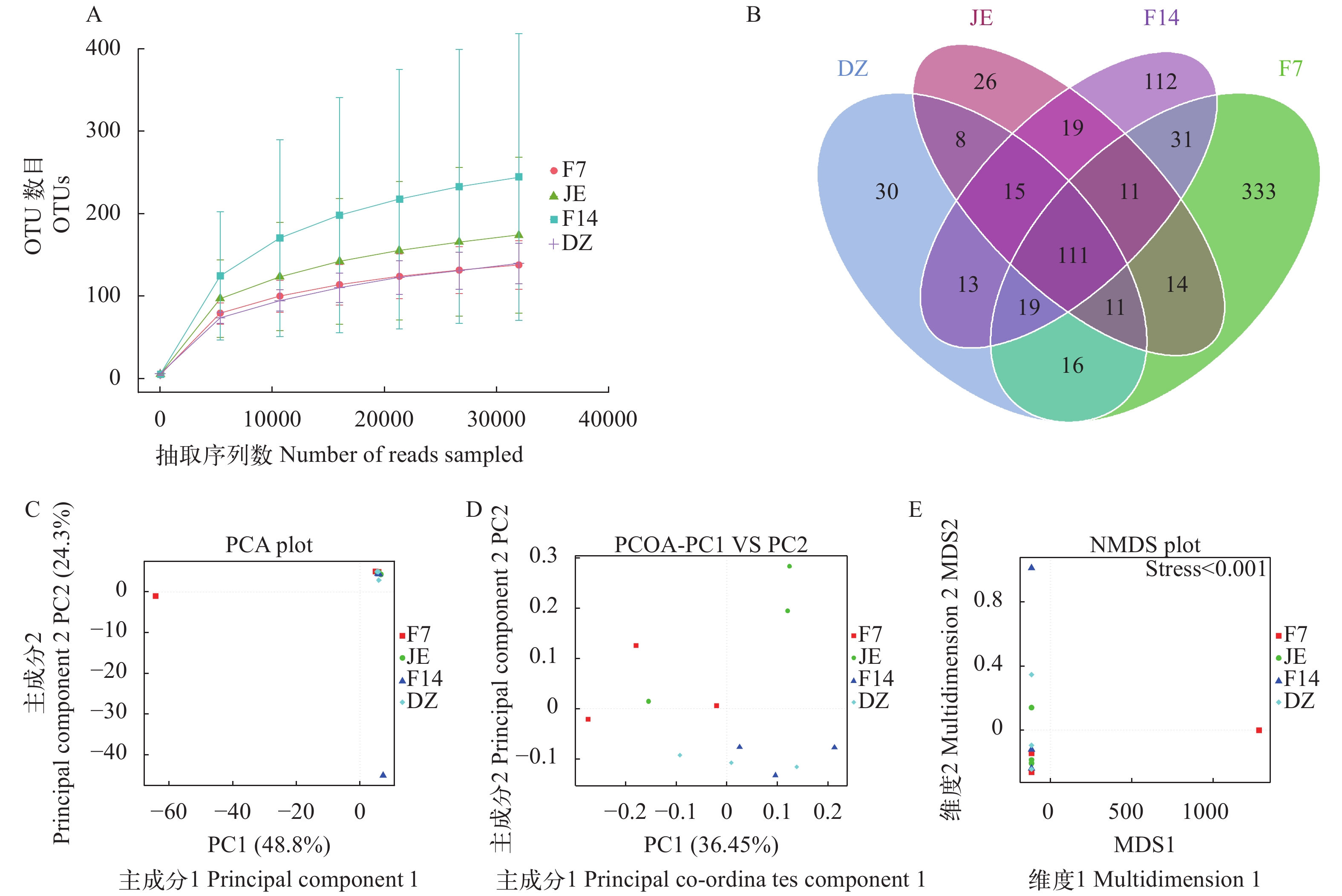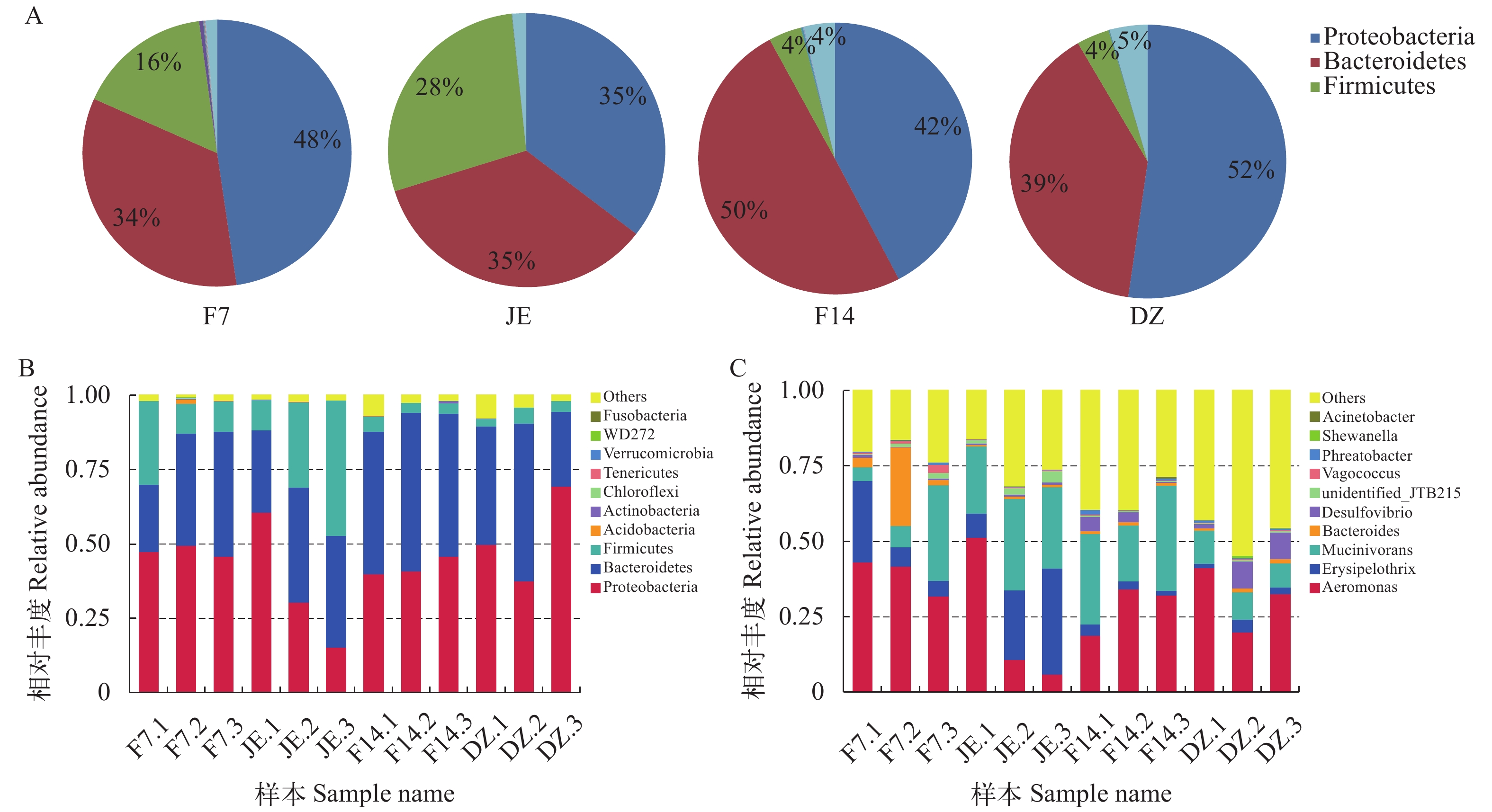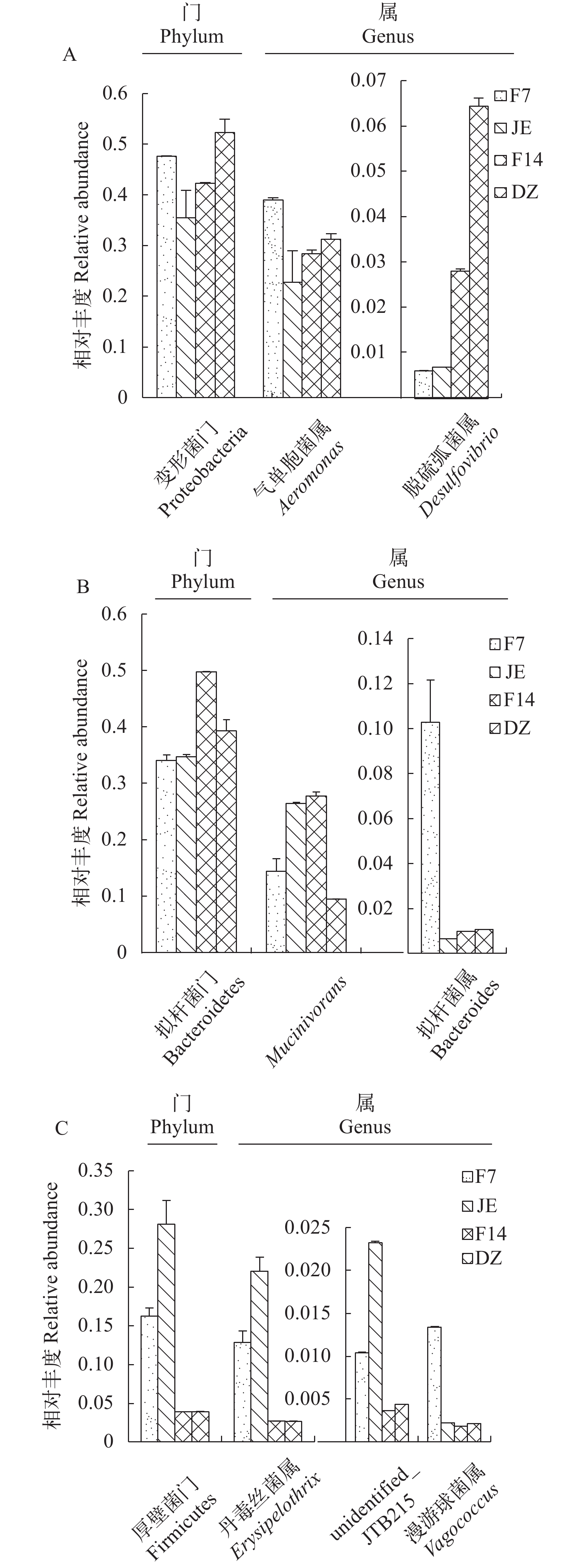EFFECTS OF FASTING AND REFEEDING ON HIRUDO NIPPONIA INTESTINAL MICROFLORA DIVERSITY
-
摘要: 为了研究饥饿及恢复喂食对日本医蛭肠道微生物菌群的影响, 采用高通量测序技术分析了正常组、饥饿30d、恢复喂食7d以及恢复喂食14d的日本医蛭肠道微生物菌群特征及多样性的变化。结果显示: 日本医蛭核心菌群门水平上, 主要集中于变形菌门(Proteobacteria)、拟杆菌门(Bacteroidetes)、厚壁菌门(Firmicutes), 属水平核心菌群有气单胞菌属(Aeromonas)、Mucinivorans属、拟杆菌属(Bacteroides)、丹毒丝菌属(Erysipelothrix)等。饥饿及恢复摄食, 对气单胞菌属、Mucinivorans属在内的核心菌群多样性及丰度产生了一定的影响。本研究为揭示日本医蛭肠道菌群组成以及研究日本医蛭消化道微生物功能奠定了基础。Abstract: In this study, we utilized high-throughput sequencing technology to explore thechanges of intestinal microbiota of Hirudo nipponia among fasting group, refeeding groups and control group. The results showed that (1) on the hierarchical level of the phylum, the microflora mainly include Proteobacteria, Bacteroidetes and Firmicutes; (2) on the hierarchical level of genera, the dominate microflora include Aeromonas, Mucinivorans, Bacteroides and Erysipelothrix. The results also indicated that fasting and refeeding diversity and abundance of the dominate microflora, including Aeromonas and Mucinivorans. This study lays the foundation for more detailed composition and function of digestive tract microflora in H. nipponia.
-
Keywords:
- Hirudo nipponia /
- Intestinal microflora /
- High-throughput sequencing /
- Fasting /
- Refeeding
-
动物肠道内栖息了数量庞大的微生物群落, 这些微生物群在宿主肠道构成了复杂的微生态系统, 在营养物质消化吸收、宿主免疫功能调节、有害微生物侵害防御等方面具有重要作用[1—3]。研究表明, 动物肠道微生物菌群组成及变化, 可能受到多种因素的影响, 如饲料[4]、日龄[5, 6]、免疫状态[7]、环境因素[8]、抗生素治疗[9]和应激[10]等。因此, 研究动物肠道微生物菌群及在特定情况下的变动, 对于阐明肠道微生物促进动物体的消化吸收、生长发育、免疫防御等方面具有重要意义, 对于补充诠释宿主-肠道菌群互作机制也具有重要价值。
医学蛭类如欧洲医蛭(Hirudo medicinalis)、侧纹医蛭(Hirudo verbana)等体内含有大量抗凝、抗血栓等生物活性成分, 而被广泛研究。医蛭体内的肠道微生物与宿主的共生关系以及对宿主的有益效果, 也是科学界研究的重点。日本医蛭(Hirudo nipponia Whitman, 1886)隶属于环节动物门蛭纲无吻蛭目医蛭属[11], 是中国药典(2015年版)收载的唯一吸食动物血液的水蛭药材种类[12]。临床研究表明, 水蛭在治疗动脉粥样硬化[13]、高脂血症[14]、抗血栓[15]、抗肿瘤[16]、抗炎症[17]等方面有较好的疗效。日本医蛭药用史最早可追溯至《神农本草经》, 由于其体内含有世界上最强的天然抗凝血酶类物质—水蛭素, 因此具有极强的抗凝血酶活性和抗血小板聚集作用[18]。以日本医蛭为原料的脉血康胶囊在治疗心脑血管疾病方面具有极好的市场反应, 产品供不应求[19]。受环境污染、人为过度捕捞、栖息地急剧萎缩等因素的影响, 日本医蛭野外种群量急剧下降, 曾经遍布全国的日本医蛭, 现在难寻其踪。本课题组开展了多年日本医蛭人工养殖研究及实践。在人工养殖过程中, 课题组发现日本医蛭能够在饥饿状态下维持生命体征长达半年以上, 处于饥饿状态的医蛭在喂食血液后, 能够急剧生长。推测是存在于日本医蛭体内的肠道微生物菌群发挥了极其重要的作用。
现阶段关于日本医蛭肠道微生物菌群、饥饿及恢复摄食对日本医蛭肠道微生物菌群影响等方面的研究, 还未见任何报道。为此本课题组利用不依赖于传统培养的高通量测序技术, 对饥饿及恢复摄食状态下的日本医蛭肠道微生物菌群进行了研究。以期揭示日本医蛭肠道微生物菌群组成、肠道微生物菌群对日本医蛭不同摄食状态的反应以及可能发挥的作用, 为日本医蛭人工养殖产业化、肠道微生物菌群对日本医蛭有益作用机制研究等奠定基础, 也为其他宿主-肠道微生物互作机制研究提供参考。
1. 材料与方法
1.1 实验材料
本研究所用日本医蛭均来源于重庆市中药研究院水蛭养殖基地。各选取100尾健康无病、表面无伤痕、个体大小相近的日本医蛭正常个体, 分别暂养于4个相同的养殖网箱。其中1个网箱饥饿处理30d (JE), 1个为正常饲养对照组(DZ), 另外2组均饥饿30d后喂食1次, 投喂结束后第7、第14天取样, 分别记作F7、F14。整个养殖期间, 水温20—22℃, 溶氧≥5 mg/L, pH=7.0±0.2, 饲料为新鲜健康猪血。各组分别设置三个生物学重复, 每个重复选取10尾日本医蛭。
1.2 肠道菌群收集
实验日本医蛭用75%酒精体表消毒, 于无菌条件下, 1.5 mL离心管收集肠道及其内容物, 做好标记后液氮冻存。
1.3 基因组抽提
采用CTAB/SDS方法对样本的基因组DNA进行提取, 利用1%琼脂糖凝胶电泳检测DNA的浓度和纯度, 使用无菌水将DNA浓度稀释至1 ng/μL。
1.4 16S rRNA基因序列的扩增
以稀释后的基因组DNA为模板, 选取细菌基因组16S区域中V4区作为扩增区域, 用Phusion® High-Fidelity PCR Master Mix with GC Buffer和高效高保真酶进行PCR。扩增V4区引物以515F (5′-GTGCCAGCMGCCGCGGTAA-3′)及806R (5′-GGACTACHVGGGTWTCTAAT-3′)上加有接头和测序引物序列, 同时反向引物上另接有12个不同碱基的标签(Barcode)序列以区分不同样品[20]。扩增产物采用Qiangen胶回收试剂盒(Qiagen Gel Extraction Kit, Qiagen, Germany)进行琼脂糖凝胶电泳回收纯化。
1.5 16S rRNA文库构建
按照TruSeq® DNA PCR-Free Sample Preparation Kit (Illumina, USA)说明手册进行文库构建。文库质检采用Qubit@ 2.0 Fluorometer (Thermo Scientific)和Agilent Bioanalyzer 2100 system。在Illumina HiSeq2500测序平台进行上机测序。测序服务由北京诺禾致源生物公司完成。
1.6 数据分析
根据Barcode序列和PCR扩增引物序列从下机数据中拆分出各样品数据, 截去Barcode和引物序列后使用FLASH (Version 1.2.7)[21]对每个样品的reads进行拼接, 获得Tags数据(Raw Tags); 参照Qiime (Version 1.7.0)[22]的Tags质量控制流程, 过滤去除低质量、短长度及嵌合体后得到高质量、用于分析的Tags数据(Effective Tags)。
利用Uparse软件(Version7.0.1001)[23]对所有样品的全部Effective Tags进行聚类, 以97%的一致性(Identity)将序列聚类成为OTUs (Operational Taxonomic Units)。选取OTUs的代表性序列, 进行注释分析, 利用Mothur方法与SILVA[24]的SSUrRNA数据库[25]进行物种注释分析(设定阈值为0.8—1), 获得分类学信息并分别在各个分类水平: phylum (门)、class (纲)、order (目)、family (科)、genus (属)、species (种)统计各样本的群落组成。
使用Qiime软件(Version 1.7.0)计算Observed-species, Chao1, Shannon, ACE等指数, 使用R软件(Version 2.15.3)绘制稀释曲线以及Venn图, 并使用R软件进行Alpha多样性指数组间差异分析, 通过多变量统计学方法主成分分析(PCA, Principal Component Analysis)、主坐标分析(PCoA, Principal Co-ordinates Analysis)、 无度量多维标定法(NMDS, Non-Metric Multi-Dimensional Scaling)等方法, 从中发现不同样品(组)间的差异。
2. 结果
2.1 16S rRNA基因PCR扩增及测序数据合理性分析
分别抽提日本医蛭(F7、F14、JE、DZ四组样品)肠道细菌基因组DNA, 以基因组DNA为模板, PCR扩增16S rRNA目的基因后, 经琼脂糖凝胶电泳检测, PCR产物目的条带大小正确, 总量满足2次或者2次以上建库需要, 可进行后续建库试验。
Coverage指数是对测序样品覆盖率的描述, 根据表 1可见, 4组样品覆盖率均很高(≥99.8%), 说明样本序列中未被检测出的概率很低。稀疏曲线可直接反映测序数据量的合理性。从稀释曲线(图 1A)可见, 在小于约5000条序列时, OTU数量随着样品的序列数增加而迅速增加; 在5000—30000条序列时, OTU数量增加缓慢, 之后则趋向平坦。本研究的4个样品均处于平台期(图 1A), 说明测序数据量合理。测序原始数据提交至NCBI (Accession number: SRP 126606)。
表 1 四组样品α多样性分析结果Table 1. Alpha Diversity of four sets of samples样品Samples 测序序列Read 操作分类单元OTUs 丰富度指数Richness Index 覆盖率Coverage (%) 多样性指数Diversity Index Chao1指数Chao1 Ace指数Ace 香农指数Shannon F7 59791±13967 279±236 282.80±218.25 303.33±220.25 99.8±0.00 3.01±0.36 F14 49140±15751 189±120 242.55±35.23 219.96±133.36 99.9±0.00 3.15±0.28 DZ 62692±4529 173±21 186.23±60.67 196.96±50.01 99.9±0.00 3.16±0.28 JE 53379±10679 173±41 166.53±35.23 176.25±38.22 99.9±0.00 3.04±0.24 2.2 日本医蛭肠道菌群多样性分析
采用α和β多样性分析, 对日本医蛭摄食前后肠道菌群的整体结构组成变化进行描述和评价。结果显示, 4组样品获得最终用于分析的有效序列平均条数分别为59791±13967 (F7)、49140±15751 (F14)、53379±10679 (JE)和62692±4529 (DZ), OTU数目变化中, F7组最高(表 1)。Ace和Chao1指数对菌群物种总数评估发现, F7>F14>DZ>JE。
Venn图(图 1B)结果显示, 4组样品共有111个OTU, 4组样品独有OTU分别为F7﹕F14﹕DZ﹕JE=333﹕112﹕30﹕26。PCA主成分分析和PCoA主坐标分析结果(图 1C、1D)显示, 4组样品菌群结构有一定的差异。β多样性结果也显示四组样品组间有一定的差异(图 1E)。
2.3 日本医蛭肠道菌群丰度变化
在所有实验日本医蛭肠道中, 变形菌门(Proteobacteria)、拟杆菌门(Bacteroidetes)以及厚壁菌门(Firmicutes)均占据了95%以上(图 2A、2B)。同时, 在所有样品中均检测出气单胞菌属(Aeromonas)、Mucinivorans属以及丹毒丝菌属(Erysipelothrix)(图 2C), 3种菌属丰度之和在4组样品中均超过了60%(表 2), 拟杆菌属(Bacteroides)丰度仅次于上述菌属。但无论是组内还是组间都存在一定的差异, 说明饥饿及恢复摄食对日本医蛭肠道菌群的构成存在一定影响。同时也表明气单胞菌属、Mucinivorans属、拟杆菌属以及丹毒丝菌属等是日本医蛭核心肠道微生物群。
表 2 四组样品肠道菌群相对丰度分布表Table 2.This page contains the following errors:
error on line 1 at column 1: Start tag expected, '<' not foundBelow is a rendering of the page up to the first error.
种名
Species分类
TaxonomyF7 F14 DZ JE 变形菌门Proteobacteria Phylum 0.4767±0.0004 0.4232±0.0010 0.5227±0.0260 0.3549±0.0537 拟杆菌门Bacteroidetes Phylum 0.3399±0.0105 0.4976±0.0009 0.3930±0.0194 0.3468±0.0038 厚壁菌门Firmicutes Phylum 0.1622±0.0109 0.0390±0.0000 0.0389±0.0003 0.2808±0.0310 气单胞菌属Aeromonas Gunus 0.3900±0.0039 0.2840±0.0070 0.3122±0.0115 0.2281±0.0619 Mucinivorans Gunus 0.1440±0.0226 0.2778±0.0070 0.0948±0.0002 0.2648±0.0016 丹毒丝菌属Erysipelothrix Gunus 0.1285±0.0149 0.0268±0.0001 0.0263±0.0002 0.2202±0.0184 拟杆菌属Bacteroides Gunus 0.1028±0.0188 0.0099±0.0000 0.0106±0.0000 0.0066±0.0000 脱硫弧菌属Desulfovibrio Gunus 0.0061±0.0000 0.0281±0.0005 0.0643±0.0019 0.0069±0.0000 Unidentified_JTB215 Gunus 0.0104±0.0000 0.0036±0.0000 0.0044±0.0000 0.0232±0.0002 漫游球菌属Vagococcus Gunus 0.0133±0.0001 0.0018±0.0000 0.0021±0.0000 0.0022±0.0000 门分类水平下肠道菌群丰度的变化 门水平肠道丰度的变化详见表 2和图 3。在饥饿及恢复摄食状态下日本医蛭肠道菌群的变化, 在门水平表现为: 变形菌门在对照组最高, 拟杆菌门在恢复摄食14d后丰度最高。厚壁菌门在饥饿组丰度值最高。
属分类水平下肠道菌群丰度的变化 变形菌门的气单胞菌属、拟杆菌门的拟杆菌属、厚壁菌门的漫游球菌属(Vagococcus)均是在饥饿后恢复摄食7d时, 达到最高。Mucinivorans在饥饿后恢复摄食14d组达到最高, 丹毒丝菌属在饥饿状态下丰度最高(图 3和表 2)。
差异类群LEfSe分析 通过LEfSe (Linear Discriminate Analysis Effect Size)分析发现, 饥饿后恢复喂食7d组日本医蛭肠道菌群中科和属分类水平上存在差异菌群, 如拟杆菌科、拟杆菌属(图 4)。
3. 讨论
3.1 饥饿后恢复摄食对日本医蛭肠道菌群多样性的影响
动物体内的微生物群落在宿主营养代谢及免疫调节方面发挥着重要作用[26]。研究表明, 饵料的恢复投喂一方面增加了能量来源并使得微生物数量增加, 另一方面使得肠道微生物种间竞争加剧, 加速形成“优势种”并导致各微生物种类和丰度的分化[27—29]。本研究利用高通量测序技术分析了饥饿及恢复摄食对日本医蛭肠道菌群组成及多样性特征的影响。结果发现, 饥饿后恢复投喂, 日本医蛭肠道微生物多样性依次为F7>F14>DZ>JE, 与相关研究结果相符[27—29]。具体表现为, 喂食7d组肠道微生物多样性最高, 饥饿组最低。OTU数据显示与此一致的规律。
3.2 饥饿后恢复喂食对日本医蛭肠道菌群丰度及种类的影响
由于所处的宿主肠道生长环境与周围环境紧密相关, 水生动物肠道微生物菌群平衡更容易受到水体环境变化、饵料变换等因素的影响。对饥饿及恢复摄食状态下日本医蛭肠道菌群丰度变化研究发现: 在门水平, 变形菌门、拟杆菌门及厚壁菌门在正常组、饥饿组以及恢复摄食组均占据了95%以上, 为优势菌门。与同属于医蛭属的东方医蛭优势肠道菌群类似[30, 31], 与鱼类优势肠道菌群也有共同之处[32, 33]。这表明在饥饿后恢复摄食影响了日本医蛭优势菌门的丰度, 但未影响优势菌门的种类。与现有鱼类及其他脊椎动物研究的结果略为不同, 饥饿及恢复摄食对鱼类等脊椎动物优势菌群丰度和种类均可能产生一定的影响[27, 34, 35], 但在本研究中日本医蛭优势菌门种类却几乎未变, 究其原因可能与鱼类及其他陆生脊椎动物喂食的饲料, 本身就含有较多的外源微生物, 而本研究中日本医蛭系人工饲养, 以消毒的肠衣填充新鲜健康猪血投喂, 因而所含的外源微生物较少有关。
在属分类水平, 以气单胞菌属、Mucinivorans属、拟杆菌属以及丹毒丝菌属等组成了日本医蛭核心肠道微生物群, 这一发现与已有欧洲医蛭[36]、侧纹医蛭[37]、东方医蛭[38]以及北美医蛭[39]研究结果基本一致。气单胞菌属具有溶解血细胞的溶血素功能[40], 可参与消化医蛭摄食的血液[41]。在本研究中, 日本医蛭在饥饿恢复摄食后, 气单胞菌属数量迅速上升, 可能与食物消化等功能相关。Mucinivorans为理岩菌科新属[42, 43], 该菌参与厌氧代谢, 并利用碳水化合物作为能量来源[44], 将葡萄糖、乳糖、甘露糖和蜜二糖等代谢为醇类、乙酸、丙酸、甲酸和琥珀酸[42], 还可以代谢水蛭肠细胞分泌的黏液, 为肠道微生物菌群定植提供有利条件[40]。本研究中饥饿的日本医蛭在摄食后, Mucinivorans出现不同水平的回升, 与已有研究结果一致[45, 46]。可能是由于日本医蛭吸食血液后, Mucinivorans参与食物中碳水化合物代谢, 为机体提供能量有关[46]。脱硫弧菌属、拟杆菌属均在饥饿摄食后水平有所回升, 可能与日本医蛭的消化、营养吸收等功能也较为相关。此外, 丹毒丝菌属在饥饿状态下水平达到最高, 其具体功能及作用还有待进一步研究。
-
表 1 四组样品α多样性分析结果
Table 1 Alpha Diversity of four sets of samples
样品Samples 测序序列Read 操作分类单元OTUs 丰富度指数Richness Index 覆盖率Coverage (%) 多样性指数Diversity Index Chao1指数Chao1 Ace指数Ace 香农指数Shannon F7 59791±13967 279±236 282.80±218.25 303.33±220.25 99.8±0.00 3.01±0.36 F14 49140±15751 189±120 242.55±35.23 219.96±133.36 99.9±0.00 3.15±0.28 DZ 62692±4529 173±21 186.23±60.67 196.96±50.01 99.9±0.00 3.16±0.28 JE 53379±10679 173±41 166.53±35.23 176.25±38.22 99.9±0.00 3.04±0.24 表 2 四组样品肠道菌群相对丰度分布表
Table 2
This page contains the following errors:
error on line 1 at column 1: Start tag expected, '<' not foundBelow is a rendering of the page up to the first error.
种名
Species分类
TaxonomyF7 F14 DZ JE 变形菌门Proteobacteria Phylum 0.4767±0.0004 0.4232±0.0010 0.5227±0.0260 0.3549±0.0537 拟杆菌门Bacteroidetes Phylum 0.3399±0.0105 0.4976±0.0009 0.3930±0.0194 0.3468±0.0038 厚壁菌门Firmicutes Phylum 0.1622±0.0109 0.0390±0.0000 0.0389±0.0003 0.2808±0.0310 气单胞菌属Aeromonas Gunus 0.3900±0.0039 0.2840±0.0070 0.3122±0.0115 0.2281±0.0619 Mucinivorans Gunus 0.1440±0.0226 0.2778±0.0070 0.0948±0.0002 0.2648±0.0016 丹毒丝菌属Erysipelothrix Gunus 0.1285±0.0149 0.0268±0.0001 0.0263±0.0002 0.2202±0.0184 拟杆菌属Bacteroides Gunus 0.1028±0.0188 0.0099±0.0000 0.0106±0.0000 0.0066±0.0000 脱硫弧菌属Desulfovibrio Gunus 0.0061±0.0000 0.0281±0.0005 0.0643±0.0019 0.0069±0.0000 Unidentified_JTB215 Gunus 0.0104±0.0000 0.0036±0.0000 0.0044±0.0000 0.0232±0.0002 漫游球菌属Vagococcus Gunus 0.0133±0.0001 0.0018±0.0000 0.0021±0.0000 0.0022±0.0000 -
[1] Gill S R, Pop M, Deboy R T, et al. Metagenomic analysis of the human distal gut microbiome [J]. Science, 2006, 312(5778): 1355—1359
[2] Turnbaugh P J, Ley R E, Hamady M, et al. The human microbiome project: exploring the microbial part of ourselves in a changing world [J]. Nature, 2007, 449(7164): 804—810
[3] Upadhyay V, Poroyko V, Kim T J, et al. Lymphotoxin regulates commensal responses to enable diet-induced obesity [J]. Nature Immunology, 2012, 13(10): 947—953
[4] 吴昌新, 孙新, Wendy G. 利用日粮配方技术调控家禽肠道菌群. 国外畜牧学-猪与禽, 2006, 26(1): 30—32 Wu C X, Sun X, Wendy G. Dietary strategies to influence bacterial microflora in pigs [J]. Pigs and Poultry, 2006, 26(1): 30—32
[5] 杨睿, 黎春秀, 付利芝, 等. 不同日龄家兔肠道微生物群落结构. 中国兽医学报, 2017, 37(9): 1693—1698 Yang R, Li C X, Fu L Z, et al. Intestinal microbial community structure changes and analysis in the growth of weaning young rabbits [J]. Chinese Journal of Veterinary Science, 2017, 37(9): 1693—1698
[6] 吴高峰. 应用PCR-DGGE技术对不同日龄仔猪肠道菌群分布规律的研究. 硕士学位论文, 河南农业大学, 郑州. 2009 Wu G F. Investigation of gastrointestinal microbial flora in piglets with different ages by PCR-DGGE [D]. Thesis for Master of Science. Henan Agricultural University, Zhengzhou. 2009
[7] 李苗, 孙迪, 付冰冰, 等. 肠道菌群与自身免疫性疾病研究进展. 中国微生态学杂志, 2015, 27(10): 1233—1237 Li M, Sun D, Fu B B, et al. Research on gut microbiota and autoimmune disease: progress review [J]. Chinese Journal of Microecology, 2015, 27(10): 1233—1237
[8] 徐绸, 何平, 刘长庭. 空间环境对肠道菌群的影响. 航天医学与医学工程, 2016, 29(4): 297—300 Xu C, He P, Liu C T. Effects of space environment on intestinal flora [J]. Space Medicine & Medical Engineering, 2016, 29(4): 297—300
[9] Murphy E F, Cotter P D, Hogan A, et al. Divergent metabolic outcomes arising from targeted manipulation of the gut microbiota in diet-induced obesity [J]. Gut, 2013, 62: 220—226
[10] Sun Y D, Zhang M, Chen C C, et al. Stress induced corticotropin releasing hormone-mediated NLRP6 inflammasome inhibition and transmissible enteritis in mice [J]. Gastroenterology, 2013, 144(7): 1478—1487
[11] 杨潼. 中国动物志. 环节动物门: 蛭纲. 北京: 科学出版社. 1996, 110—115 Yang T. Fauna Sinica, Annelida: Hirudinea [M]. Beijing: Science Press. 1996, 110—115
[12] 国家药典委员会. 中华人民共和国药典: 一部. 北京: 中国医药科技出版社. 2015 Chinese Pharmacopoeia Commission. Pharmacopoeia of People’s Republic of China: One Edition [S]. Beijing: China Medical Science Press. 2015
[13] 郭光业, 郑彩华, 赵剑锋, 等. 复方水蛭胶囊防治动脉粥样硬化单因素效应分析. 时珍国医国药, 2007, 18(3): 531—532 Guo G Y, Zheng C H, Zhao J F, et al. Single factor analysis on effect of compound shuizhi capsule in preventing and treating atherosclerosis [J]. Lishizhen Medicine and Materia Medica Research, 2007, 18(3): 531—532
[14] 杨洪雁, 张香东, 刘可园, 等. 水蛭对血瘀证家兔血脂代谢及相关基因表达的影响. 中国现代应用药学, 2013, 30(9): 959—963 Yang H Y, Zhang X D, Liu K Y, et al. Effects of hirudo on blood metabolism and its related gene expression in blood stasis syndrome rabbits [J]. Chinese Journal of Modern Applied Pharmacy, 2013, 30(9): 959—963
[15] 梁进权, 王宁生, 宓穗卿. 水蛭抗凝抗血栓活性及其与品种、提取方法的关系. 中西医结合心脑血管病杂志, 2009, 7(9): 1096—1098 Liang J Q, Wang N S, Mi S Q. The relation between anticoagulant and antithrombotic activity of leech and its variety and extraction method [J]. Chinese Journal of Integrative Medicine on Cardio-/Cerebro Vascular Disease, 2009, 7(9): 1096—1098
[16] 田雪飞, 孙婧, 方圆, 等. 水蛭提取物对肝癌HepG2细胞DNA去甲基化作用研究. 湖南中医药大学学报, 2011, 31(9): 8—11 Tian X F, Sun J, Fang Y, et al. Study of leech extract on DNA demethylation inHepG2 [J]. Journal of TCM University of Hunan, 2011, 31(9): 8—11
[17] 谢艳华, 王四旺, 郭倩. 中药水蛭抗炎作用的实验研究. 第四军医大学学报, 1996, 17(6): 431—433 Xie Y H, Wang S W, Guo Q. Experimental study on anti-inflammatory function of hirudo [J]. Journal of the Fourth Military Medical University, 1996, 17(6): 431—433
[18] 鲁增辉, 石萍, 陈仕江. 水蛭(日本医蛭)皮肤及消化系统组织学研究. 中药材, 2016, 39(8): 1738—1741 Lu Z H, Shi P, Chen S J. Study on integumentary and digestive system of Hirudo nipponica [J]. Journal of Chinese Medicinal Materials, 2016, 39(8): 1738—1741
[19] Ge C J, Yuan F, Feng L X, et al. Clinical effect of Maixuekang Capsule on long-term prognosis in patients with acute coronary syndrome after percutaneous coronary intervention [J]. Chinese Journal of Integrative Medicine, 2014, 20(2): 88—93
[20] Caporaso J G, Lauber C L, Walters W A, et al. Ultra-high-throughput microbial community analysis on the Illumina HiSeq and MiSeq platforms [J]. ISME Journal, 2012, 6(8): 1621—1624
[21] Magoč T, Salzberg S L. FLASH: fast length adjustment of short reads to improve genome assemblies [J]. Bioinformatics, 2011, 27(21): 2957—2963
[22] Caporaso J G, Kuczynski J, Stombaugh J, et al. QⅡME allows analysis of high-throughput community sequencing data [J]. Nature Methods, 2010, 7(5): 335—336
[23] Edgar R C. UPARSE: highly accurate OTU sequences from microbial amplicon reads [J]. Nature Methods, 2013, 10(10): 996—998
[24] Wang Q, Garrity G M, Tiedje J M, et al. Naive Bayesian classifier for rapid assignment of rRNA sequences into the new bacterial taxonomy [J]. Applied and Environmental Microbiology, 2007, 73(16): 5261—5267
[25] Quast C, Pruesse E, Yilmaz P, et al. The SILVA ribosomal RNA gene database project: improved data processing and web-based tools [J]. Nucleic Acids Research, 2013, 41(Database issue): D590—D596
[26] 张美玲, 杜震宇. 水生动物肠道微生物研究进展. 华东师范大学学报, 2016, 1(1): 1—8 Zhang M L, Du C Y. Review and perspective: Function of intestinal microbiota in acquatic animals [J]. Journal of East China Normal University, 2016, 1(1): 1—8
[27] 李星浩, 颜庆云, 胡红娟, 等. 异育银鲫消化道微生物群落对恢复投喂的响应. 水生生物学报, 2014, 38(5): 854—859 Li X H, Yan Q Y, Hu H J, et al. Effects of refeeding on the diversity of intestinal microflora in allogynogenetic crucial carp (Carassius auratus gibelio) [J]. Acta Hydrobiologica Sinica, 2014, 38(5): 854—859
[28] 谭啸. 微囊藻在水华优势种形成过程中若干生物学特性的研究. 硕士学位论文, 南京师范大学, 南京. 2006 Tan X. Reseacrhes on several biological character ofmicrocystis during water bloom dominant species forming [D]. Thesis for Master of Science. Nanjing Normal University, Nanjing. 2006
[29] 钟蕾, 向建国, 曾丹, 等. 饵料对鳡肠道微生物多样性的影响. 水生生物学报, 2016, 40(4): 830—835 Zhong L, Xiang J G, Zeng D, et al. Effects of different diets on intestinal microbiota of Elopichthys bambusa [J]. Acta Hydrobiologica Sinica, 2016, 40(4): 830—835
[30] Whitaker I S, Maltz M, Siddall M E, et al. Characterization of the digestive tract microbiota of Hirudo orientalis (medicinal leech) and antibiotic resistance profile [J]. Plasticand Reconstructive Surgery, 2014, 133(3): 408e—418e
[31] Worthen P L, Gode C J, Graf J. Culture-independent characterization of the digestive-tract microbiota of the medicinal leech reveals a tripartite symbiosis [J]. Applied and Environmental Microbiology, 2006, 72(7): 4775—4781
[32] Kormas K A, Meziti A, Mente E, et al. Dietary differences are reflected on the gut prokaryotic community structure of wild and commercially reared sea bream (Sparus aurata) [J]. Microbiology Open, 2014, 3(5): 718—728
[33] Wu S, Gao T, Zheng Y, et al. Microbial diversity of intestinal contents and mucus in yellow catfish (Pelteobagrus fulvidraco) [J]. Aquaculture, 2010, 303(1-4): 1—7
[34] Dhanasiri A K S, Brunvold L, Brinchmann M F, et al. Changes in the intestinal microbiota of wild Atlantic cod Gadus morhua L. upon captive rearing [J]. Microbial Ecology, 2011, 61(1): 20—30
[35] Claesson M J, Jeffery I B, Conde S, et al. Gut microbiota composition correlates with diet and health in the elderly [J]. Nature, 2012, 488(7410): 178—184
[36] Graf J. Symbiosis of Aeromonas veronii biovar sobria and Hirudo medicinalis, the medicinal leech: a novel model for digestive tract associations [J]. Infection and Immunity, 1999, 67(1): 1—7
[37] Nelson M C, Graf J. Bacterial symbioses of the medicinal leech Hirudo verbana [J]. Gut Microbes, 2012, 3(4): 322—331
[38] Laufer A S, Siddall M E, Graf J. Characterization of the digestive-tract microbiota of Hirudo orientalis, a European medicinal leech [J]. Applied and Environmental Microbiology, 2008, 74(19): 6151—6154
[39] Mark E S, Paul L W, Matthew J, et al. Novel role for Aeromonas jandaei as a digestive tract symbiont of the north American medicinal leech [J]. Applied and Environmental Microbiology, 2017, 73(2): 655—658
[40] Bomar L, Maltz M, Colston S, et al. Directed culturing of microorganisms using metatranscriptomics [J]. Mbio, 2011, 2(2): e00012—11
[41] Maltz M A, Bomar L, Lapierre P, et al. Metagenomic analysis of the medicinal leech gut microbiota [J]. Frontiers and Microbiology, 2014, 5(151): 1—12
[42] Nelson M C, Bomar L, Graf J. Complete genome sequence of the novel leech symbiont Mucinivorans hirudinis M3T [J]. Genome Announcements, 2015, 3(1): e01530—14
[43] Nelson M C, Bomar L, Maltz M, et al. Mucinivorans hirudinis gen. nov. , sp. nov. , an anaerobic, mucin-degrading bacterium isolated from the digestive tract of the medicinal leech Hirudo verbena [J]. International Journal of Systematic and Evolutionary Microbiology, 2015, 65(Pt 3): 990—995
[44] Marden J N, Mcclure E A, Lidia B, et al. Host matters: medicinal leech digestive-tract symbionts and their pathogenic potential [J]. Frontiers in Microbiology, 2016, 7(e0115813): 1—11
[45] Bomar L, Graf J. Investigation into the physiologies of Aeromonas veronii in vitro and inside the digestive tract of the medicinal leech using RNA-seq [J]. Biological Bulletin, 2012, 223(1): 155—166
[46] Kikuchi Y, Graf J. Spatial and temporal population dynamics of a naturally occurring two-species microbial community inside the digestive tract of the medicinal leech [J]. Applied and Environmental Microbiology, 2007, 73(6): 1984—1991
-
期刊类型引用(5)
1. 余米,曹敏,苏胜齐,封孝兰. 低温处理下日本医蛭及其环带组织转录组差异表达基因分析. 安徽农业大学学报. 2025(01): 40-48 .  百度学术
百度学术
2. 刘妮,彭作刚. 玫瑰高原鳅肠道微生物多样性研究. 水生生物学报. 2021(01): 118-124 .  本站查看
本站查看
3. 李赫,于翔,张健. 饥饿与重摄食对野生日本医蛭肠道菌群结构的影响. 辽东学院学报(自然科学版). 2021(02): 91-100 .  百度学术
百度学术
4. 石萍,卫坚,游华建,鲁增辉,陈仕江. 温度骤变对日本医蛭肠道菌群的影响. 中国微生态学杂志. 2021(07): 752-758 .  百度学术
百度学术
5. 蒲德成,曹敏,余米. 不同养殖地区日本医蛭的生长及抗凝血活性研究. 安徽农业科学. 2021(23): 121-123 .  百度学术
百度学术
其他类型引用(4)



 下载:
下载:



